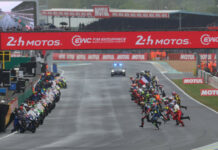Threats to motorcycling in America, Part 2 The AMA’s Rob Dingman discusses the challenge of excessive sound PICKERINGTON, Ohio — For the past 21 months, American Motorcyclist Association (AMA) President and CEO Rob Dingman has been leading the world’s largest motorcyclists’ rights organization through a reorganization to rededicate the AMA to its core mission: protecting and promoting the future of motorcycling and the motorcycle lifestyle. In this interview — the second of a three-part series by AmericanMotorcyclist.com — Dingman discusses the most contentious issue in motorcycling today: excessive sound. AM: Many street riders have a long-held belief that a loud exhaust system alerts car and truck drivers to their presence. Yet cities and towns across America are enacting very strict sound ordinances that target motorcycles unfairly. What is the AMA doing about this? RD: The single greatest threat to motorcycling in America — both on- and off-highway, including ATVs — is excessive exhaust sound. Nearly everyone we talk to in the motorcycling and OHV (off-highway vehicle) community echoes this concern. For many riders, their machines are an extension of their personalities, and this includes the distinctive sound of their engine’s exhaust. I completely understand that. But as motorcyclists, we have to realize that we live in a world already filled with unwanted distractions, and chief among them is sound that is so excessive that it becomes a nuisance to the general public. Excessive exhaust sound plants targets squarely on the backs of all riders, even those who ride with reasonably quiet exhaust systems. It is important to remember that this problem is not limited to motorcycles and OHVs. Loud cars and trucks, booming car stereos, poorly maintained generators, whining leaf blowers — they are all part of the problem. However, just because there are other sources of unwanted noise does not mean that the motorcycling community can excuse itself. We have to be part of the solution. So to answer the question, the AMA and our sister organization, the ATVA (All-Terrain Vehicle Association), must simultaneously do two things. First, we have to get our own house in order, and by that I mean all riders must take an active role in the self-regulation of sound. Second, we have to stand up against government actions that unfairly single out motorcycles and OHVs for discriminatory or punitive enforcement. AM: What role can the AMA and ATVA take in the self-regulation of excessive sound? RD: The first thing we have to do — through publicity, peer pressure and support of appropriate sound ordinances — is tell our friends and acquaintances who ride loud bikes and OHVs to tone it down. We need to lead by example and convey the idea that it is totally unacceptable to ride an obnoxiously loud machine. Next, we have to stop installing unmuffled exhaust systems on our bikes. Thundering cruisers with straight pipes, howling sport bikes with competition exhausts, and barking dirt bikes and OHVs with unpacked silencers have no place on our public streets and trails. While I realize this statement may cost the AMA and ATVA some members, if we continue to ignore the serious and negative impact that excessively loud bikes and OHVs are having in our communities, we are going to see more draconian measures to restrict sound, more targeting of riders, and fewer places where we are allowed to ride. Just one irresponsible rider can negatively impact the rights of countless others. AM: Have you seen any progress to date? RD: The AMA and its partners started a public dialog about excessive sound in the early 2000s, and the OHV community has embraced the concept of quieter motorcycles and ATVs in a big way. We have seen leadership emerge among the sport’s heroes and influencers. For example, at the invitational Colorado 500, which attracts the industry’s movers and shakers, the organizers have brought down the sound of their off-road bikes from well over 100 dB(A) to 96 dB(A) using the SAE J1287 stationary sound measurement standard. It’s become a matter of pride for entrants to have the quietest bike. And when these riders go home, they set the example for others to follow. California is another example. AMA districts and clubs have been at the forefront of the issue, and were key participants to changes made in the state law. Today they are actively enforcing 96 dB(A) at their events. The manufacturers’ professional racing teams are also involved, and this year both AMA Supercross and Motocross machines must meet the FIM-developed 94 dB(A) standard. And starting in 2011, AMA Racing will be enforcing similar standards in amateur racing. There’s more good news: Many more aftermarket exhaust manufacturers build high-quality exhaust systems that readily meet these standards with no degradation in performance. The AMA supports these grass-roots efforts by providing sound-testing equipment to our districts and clubs through a grant program. The kits help test the sound level of OHVs to help riders understand how loud — or quiet — their bikes are, and also ensure that competition machines are in compliance with AMA standards. AM: What challenges remain? RD: While we have made headway in the OHV community, there are still OHV and motocross riders who run excessively loud exhausts, so we have more work to do here. Beyond that, our most pervasive challenge today is in the streetbike community, where loud bikes are all-too-common. The same measures that are working with OHV riders — peer pressure and self-regulation — are what is needed to bring about tangible change. Fortunately, most riders, and a number of clubs, have seen the writing on the wall and are already talking to their members about quieting down their bikes. The key is to regulate ourselves before the government does it for us. We certainly won’t like their solution. AM: If the AMA is in favor of reducing excessive sound, why does the AMA oppose ordinances and legislation intended to do just that? RD: Great question. The AMA opposes measures that target only motorcycles, and measures that are unfair. If an ordinance or a bill considers all noise sources — not just motorcycles — and is reasonable in its solution, then we can support it. And we have done so. Nevertheless, we must remain vigilant against poorly crafted legislation that singles out motorcycles and OHVs from other vehicles and offending sound sources. This is currently the case in New York City, where a proposed sound ordinance would mandate an EPA-stamped motorcycle exhaust system, effectively requiring an OEM (original equipment manufacturer) system for streetbikes up to 20 years old. So we are working to oppose badly thought-out initiatives, while at the same time educating legislators about fair and reasonable strategies to curb excessive sound. AM: What can we expect next? RD: The AMA and ATVA are taking a leadership position in this effort by saying that obnoxiously loud bikes and OHVs are not acceptable, and that we will work with riders to demonstrate the benefits of quieter exhausts. We want to positively influence our peers and quiet excessively loud motorcycles and OHVs to ensure greater access to public lands and city streets, plus the continued availability of accessory exhaust systems. Also, we are looking forward to seeing an SAE-developed, easy-to-implement streetbike sound standard and testing method that will help municipalities enforce reasonable measures to reduce excessive sound. With these tools we can demonstrate that the motorcycling and OHV communities are acting responsibly when it comes to sound. I can’t stress enough that curbing excessive sound is the most important issue that we can address today. We have to do this if we want to expand opportunities for riders, reduce threats to riding and usher in a new generation of riders who are not limited by bike bans, land closures and unjust regulation. If we do this, we can get back to what riding motorcycles is all about — having fun. Next installment: Rob Dingman discusses the AMA’s comprehensive approach to rider safety, helmet laws and rider education. About the American Motorcyclist Association Since 1924, the AMA has promoted and protected the motorcycling lifestyle. AMA members come from all walks of life and they navigate many different roads on their journey to the same destination: freedom on two wheels. As the world’s largest motorcycle organization with nearly 300,000 members, the AMA advocates for motorcyclists’ interests in the halls of local, state and federal government, the committees of international governing organizations and the court of public opinion. Through member clubs, promoters and partners, the AMA sanctions more motorsports competition events than any other organization in the world. Through its Motorcycle Hall of Fame Museum, the AMA preserves the heritage of motorcycling for future generations. For more information, visit www.AmericanMotorcyclist.com.
AMA: The Price Of Loud Pipes And Excessive Noise Is, Lost Rights For Motorcyclists
AMA: The Price Of Loud Pipes And Excessive Noise Is, Lost Rights For Motorcyclists
© 2009, Roadracing World Publishing, Inc.






